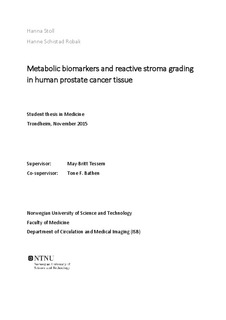| dc.description.abstract | Introduction Prostate cancer (PCa) is the most common malignancy among men in the western world. Today’s diagnostic methods are not able to separate aggressive and indolent cancer in a sufficient way. Hence, it is difficult to choose which patients who will benefit from active surveillance, and which patients should receive active treatment. The purpose of our study was to reveal more information about metabolic pathways in PCa by combining two novel and emerging diagnostic methods: reactive stroma (RS), the interaction between cancer stroma and epithelium, and metabolic profiling. A grading system for RS has already been proven to add prognostic valuable information, independent of other factors like Gleason score (GS) and Prostate specific antigen (PSA), to today’s predictive model. Altered metabolite concentrations have been found in PCa tissue versus normal tissue, and in high grade versus low grade PCa regarding citrate, spermine and choline containing compounds. The purpose of the study was to investigate whether there is a correlation between RS grade (RSG) and metabolite concentrations. The hypothesis is that RS is an active tissue that is important for cancer development and progression. Because some RSGs have been proven to lead to a worse prognosis than others, one would expect to find an alteration in phenotypes and metabolite concentrations between the different grades. Thereby this could lead to a better understanding of the molecular mechanisms in RS. Methods The tissue samples in the study came from 48 patients who underwent prostatectomy at St. Olavs Hospital, Norway. A new harvesting method was used to obtain one transversal fresh frozen slice from each of the prostates. Later, several samples from each slice were chosen for further examination. Metabolic spectra were acquired by High resolution magic angle spinning (HR-MAS) magnetic resonance spectroscopy (MRS) and each metabolite was quantified by LCModel. A histopathological evaluation considering RSG, GS and tissue composition was made on hematoxylin, erythrosine and saffron (HES) stained sections. The total number of samples was 149, of which 104 contained cancer. Finally, statistical analyses were performed in R to correlate RSG and metabolic concentrations. Linear mixed model (LMM) was used due this model`s ability to adjust for intra-patient correlation, as there are several samples from each patient in our dataset. Fixed effects also adjusted for in the LMM were GS, percentage of tumor, stroma and luminal space. In addition, the Benjamini-Hochberg false discovery rate was applied to correct for multiple testing. Descriptive analyses and log-transformation of the metabolite concentrations were performed in SPSS. Results RSG was graded in the 104 samples that contained cancer tissue. In the dataset, 23 of the samples were graded as RSG 0, 59 graded RSG 1, 16 graded RSG 2 and 6 graded RSG 3. Initially LMM proved significant differences in the concentrations of citrate (p=0,0071), ethanolamine (p= 0,0373) and glucose (p= 0,0100) between different grades of RS. However, ethanolamine and glucose showed lack of standard deviation in qq-plots, and therefore the correlation could not be confirmed. After correction for multiple testing, the p-value for citrate concentration became non-significant (p=0,1150). Discussion/conclusion The results showed that citrate concentration significantly correlated with RSG before correction for multiple testing. Citrate has previously been shown to have a negative correlation with tumor aggressiveness and GS, but these factors were adjusted for in our model. Hence the RSG can be considered to be an independent predictor of citrate concentration. This strengthens the impression of epithelial-stromal interactions as an active contributor in cancer development and progression. However, because the results did not remain significant after correction for multiple testing, it is not possible to conclude anything. Whether a correction for multiple testing was necessary in this case, or if the correction may have lead ty a type II error, can be discussed. Regardless, the association between RSG and citrate concentration is interesting and needs further investigation. Both RSG and MRS have the potential of being implemented in routine diagnostics, and their significance has already been proven in other studies. | nb_NO |
